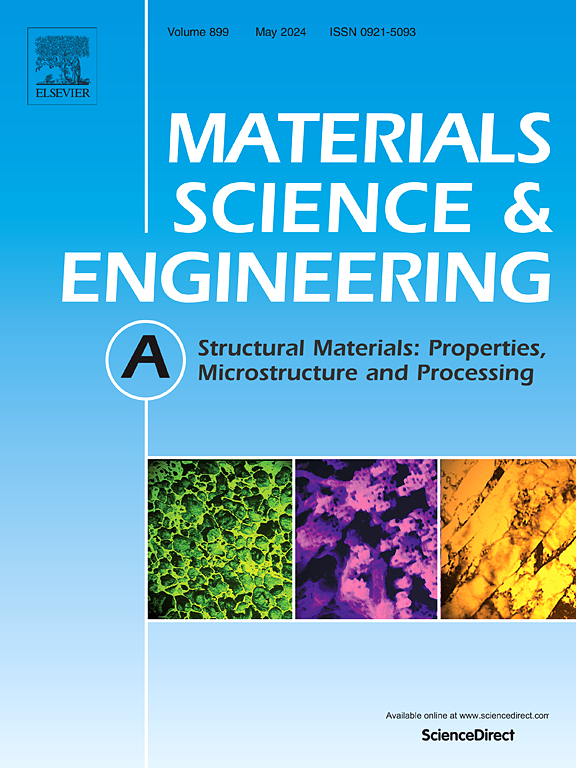通过优化预回收多级固溶处理(P-MST)初始温度改善高合金Al-Zn-Mg-Cu合金的组织和性能
IF 6.1
2区 材料科学
Q1 MATERIALS SCIENCE, MULTIDISCIPLINARY
引用次数: 0
摘要
本研究提出了一种通过优化预固溶初始温度(P-MST, T0°C/12h + 350°C/12h + 450°C/2h + 460°C/2h + 470°C/2h)来改善Al-Zn-Mg-Cu合金组织和性能的新策略。这种优化有利于位错密度、元素溶解度和晶粒尺寸的调整,从而显著提高了材料的力学性能和耐腐蚀性。研究发现,在T0°C/12h + 350°C/12h阶段,随着T0温度的升高,合金的位错密度先下降后又上升。300℃时达到最小点,导致后续MST中晶粒生长驱动力最低,在t6时效状态下晶粒尺寸最小,耐腐蚀性最佳。另外,在T0℃/12h和T0℃/12h + 350℃/12h阶段,随着T0温度的升高,第二相的平均尺寸逐渐增大。MST后基体元素溶解度在300℃时达到最高,促使合金表现出最大的时效析出强化。而在250℃时,经过t6时效处理的合金位错密度最低,应变硬化能力和塑性最高。在250℃和300℃时,合金在3.5 wt % NaCl溶液中的屈服强度分别为774 MPa和803 MPa,极限抗拉强度分别为802 MPa和823 MPa,延伸率分别为10.1%和6.9%,腐蚀电流密度分别为1.37 × 10−6 A cm−2和2.44 × 10−6 A cm−2。本文章由计算机程序翻译,如有差异,请以英文原文为准。
Improving the microstructure and properties of a high-alloyed Al-Zn-Mg-Cu alloy by optimizing the initial temperature of Pre-recovery multi-stage solution treatment (P-MST)
This study proposed a new strategy to improve the microstructure and properties of Al-Zn-Mg-Cu alloy via optimizing the initial temperature of pre-recovery multi-stage solution treatment (P-MST, T0°C/12h + 350 °C/12h + 450 °C/2h + 460 °C/2h + 470 °C/2h). This optimization facilitated the adjustment of dislocation density, element solubility, and grain size, resulting in a significant increase in mechanical properties and corrosion resistance. The research found that during the T0°C/12h + 350 °C/12h stage, as the T0 temperature increased, the alloy's dislocation density initially decreased before rising again. The minimum point was achieved at T0 of 300 °C, which led to the lowest driving force for grain growth in the subsequent MST, resulting in the smallest grain size and best corrosion resistance in the T6-aging state. Additionally, during the T0°C/12h and T0°C/12h + 350 °C/12h stages, with a rise in T0 temperature, the average size of the second phase gradually increased. The highest elemental solubility of the matrix after MST occurred at T0 of 300 °C, promoting the alloy to demonstrate the maximum aging precipitation strengthening. Nevertheless, at T0 of 250 °C, the alloy, after T6-aging treatment, presented the lowest dislocation density, thereby achieving the highest strain-hardening capacity and plasticity. At T0 of 250 °C and 300 °C, the alloy exhibited superior properties, with the yield strength of 774 MPa and 803 MPa, the ultimate tensile strength of 802 MPa and 823 MPa, the elongation of 10.1 % and 6.9 %, and the corrosion current density of 1.37 × 10−6 A cm−2 and 2.44 × 10−6 A cm−2 in 3.5 wt % NaCl solution, respectively.
求助全文
通过发布文献求助,成功后即可免费获取论文全文。
去求助
来源期刊

Materials Science and Engineering: A
工程技术-材料科学:综合
CiteScore
11.50
自引率
15.60%
发文量
1811
审稿时长
31 days
期刊介绍:
Materials Science and Engineering A provides an international medium for the publication of theoretical and experimental studies related to the load-bearing capacity of materials as influenced by their basic properties, processing history, microstructure and operating environment. Appropriate submissions to Materials Science and Engineering A should include scientific and/or engineering factors which affect the microstructure - strength relationships of materials and report the changes to mechanical behavior.
 求助内容:
求助内容: 应助结果提醒方式:
应助结果提醒方式:


